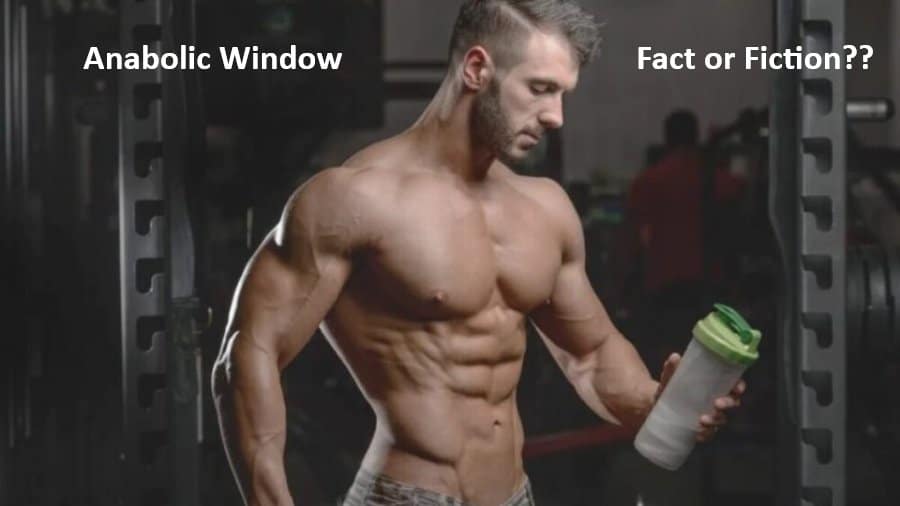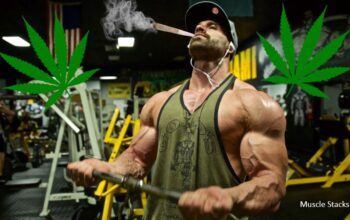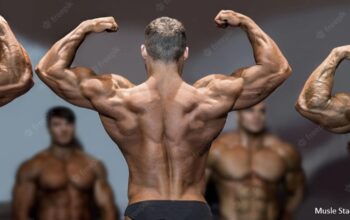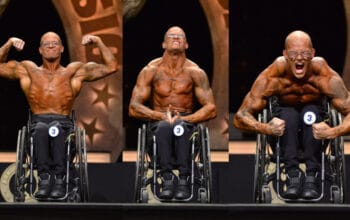Bro Lore
There is bro lore aplenty about how to be a bodybuilder. Most of it is holdovers from the 1970’s and before, but a lot of the modern bro lore sounds like science and is a pseudo scientific way to market young people. The concept is that the reason the IFBB pros today are so much bigger than before is training, supplementation, and nutrition have been refined and improved upon in the past 50 years. Obviously it has but some of it is just marketing to sell people crap.
Shit Load of Shakes
One the most inconvenient things about bodybuilding is you have to have a pre-workout meal, then a pre workout drink, then an early workout shake, then a late workout shake, then a post workout shake, then a post workout meal. So a workout ends up absorbing 5 hours of your day assuming you’re not also doing cardio or posing or tanning or sitting in the sauna to get some water out. I myself have 2,000 calories surrounding my workout and I’m CUTTING!!
You might be thinking: “I’m a bodybuilder and I don’t do that . Todd’s cray”. Yes, yes I am. But just because I’m crazy doesn’t mean I’m wrong. Even a broken clock is right twice a day.
What is the the Anabolic Window?
This is the amount of time post workout where you can consume certain nutrients to optimize the following:
- Glycogen resynthesis
- Impair muscle catabolism
- Increase muscle synthesis
In january 2013 a review and meta analysis with INTELLIGENT interpretation was posted on the NCBI database. For those of you who don’t know; forums are like the Jersey Shore of the scientific community. Any real scientist uses actual experimental data to make decisions about what to put in their body. Forums are for stuff so new and cutting edge it hasn’t been studied, and off label uses for non-bodybuilding drugs like breast cancer meds for having thinner skin etc.
I will summarize this meta analysis here and address the 3 supposed benefits of forcing food down in the anabolic window.
#1 Glycogen Resynthesis
My favorite part of this document was how they detailed how much glycogen is used up with different training modalities.
1 set of 10 bicep curls = -12% glycogen
3 sets = -24%
3 sets of 12 leg extensions=-26.1%
and 6 sets = 38%
These glycogen stores are in the type 2 fibers and its no surprise that the type 1 fibers aren’t involved at this rep range nor contribute to glycogen usage.
So it makes sense if you’re doing 20-30 sets per bodypart you’re going to deplete glycogen down to near zero.
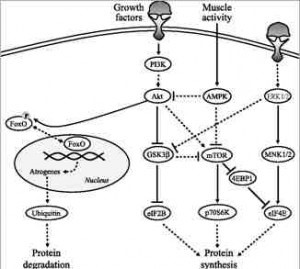
Glycogen levels in the muscle determine how the muscle responds to training; the more glycogen, the more muscle will be grown from lifting. The less glycogen, the more likely the muscle will activate the AMPK pathway and use muscle for fuel. So you don’t need to completely exhaust your muscle before losing muscle.
Two interesting caveats:
1) Its the PRE exercise glycogen level which determines the muscles responds. The more full, the more muscle growth. The less full, less muscle growth. This means it doesn’t matter what you drink while your training what matters is what you had yesterday.
2) If you do high weights and low volume then the glycogen level is irrelevant.
The researches couldn’t put this together but its real easy: If you’re dieting and low carb your glycogen will be low and you’re more likely to burn muscle with high volume. Use low volume and high weights to continue to grow muscle even in a low carb state. In the off season when mass building eat lots of carbs and do high volume for the pump and grow method.
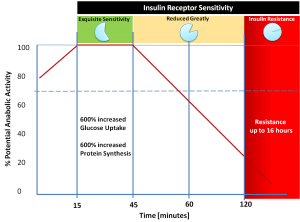
As your Glycogen levels decrease as your training GLUT 4 transporters relocate from inside the cell to the surface of the cell. These are the “doors” that carbs, amino acids, creatine, and a few other things use to get into the cell and start the recovery and growth process. SO it makes sense as you use up the carbs in the Type 2 fibers then the cell adapts to allow more carbs to enter. For this reason its believed that if you consume carbohydrates within the first 2 hours after training you will store MORE Glycogen than if you wait two hours.
This is true, you load the muscle faster, but by 8 hours post workout the muscle has the same level of glycogen regardless of if you had them right after lifting or 2 hours later. This is assuming of course the same amount of carbs are consumed, that the time you eat them MAKES NO DIFFERENCE unless you’re hitting the same body part in 8 hours.
Most of us wait 4 to 7 days which is plenty of time to recuperate glycogen supplies. “In scenarios of higher volume and frequency of resistance training, incomplete resynthesis of pre-training glycogen levels would not be a concern aside from the far-fetched scenario where exhaustive training bouts of the same muscles occur after recovery intervals shorter than 24 hours.”
Protein + Carbohydrates does result in a faster glycogen storage process, but thats due to the increase in insulin; protein + carbohydrates is a greater insulin response than either alone, and of course fat decreases the insulin response. Fox et. al., Exercise Physiology Professor at THE University of Michigan and the father of modern cardio found that even adding fat to the carbs and making the person wait more than 2 hours STILL had no impact on glycogen synthesis at the 24 hour mark.
In other words 300 carbs is 300 carbs as long as you pound them before you sleep when you have them and with what makes no difference from a GLYCOGEN RESYNTHESIS PERSPECTIVE. The effects of this cocktail on muscle synthesis is an entirely different matter….
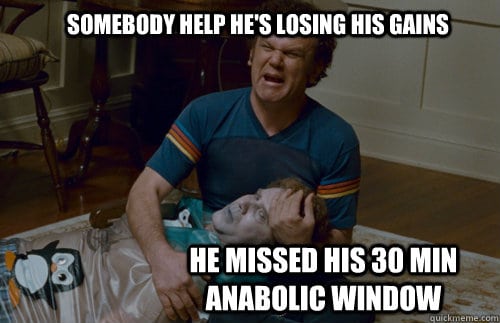
More dramatic than a teenage girl losing her cell phone, Missing your Anabolic window has been equated to throwing your whole workout away. But is it true!
Muscle Breakdown and Formation
If the rate of muscle destruction is greater than that of muscle growth you lose muscle. One reason why people pound a protein, or a protein + carb, shake post workout is to stop muscle death and start muscle growth. Turns out its the Insulin which causes the muscle destruction to stop, not the nutrients directly.
Even weirder; the shakes aren’t necessary unless you trained fasted. It seems that even a regular mixed meal causes a huge increase in insulin within 30 minutes, and this lasts for 4 hours. That means if you get a bean burrito at Taco bell at 3 pm, then even if you lift at 4 pm and don’t finish til 6 you still have 1 MORE HOUR of coverage before you could possibly lose muscle.
I know for a fact my workouts use up WAY more calories than those test subjects and i will disprove this data with my own experiences later but I want to give you an unbiased summary first before I shoot it full of holes. The idea is that insulin only needs to be 4 times above baseline to prevent muscle wasting while training. Unless your training fasted your not going to need a post workout shake, just a meal 3-6 hours after your pre workout meal depending on the size of your pre workout meal. In this example the meal was 75 g carbs, 37g protein, and 17 g fat.
45 g of whey protein caused insulin to be high after 40 minutes and it stayed elevated enough to stimulate muscle growth for 2 hours, so drinking JUST WHEY when you wake up means you can go to the gym, kill it, and you still have 20 minutes to have another shake or meal.
Take home point is no carbs are needed to stop muscle damage, protein even pre workout is enough. But it is ideal to have high glycogen stores unless you’re lifting low reps/high weight (Dave Palumbo diet system, Dorian Yates style lifting)
WHAT?!?
Basically you do not need a post workout shake within the anabolic window to replenish glycogen or to stop muscle death assuming you had a meal before the gym or even a shake. I know, thats opposite of what you thought. But your education did come from ads for protein powder in magazines didn’t it? I know in school we’re taught that no supplements are needed, just blood, sweat, and tears.
Now when it comes to MUSCLE GROWTH it’s a different matter….
Swole Shakes!
Were interested in growing muscle, otherwise we wouldn’t lift weights. There is a ton of conflicting data about if muscle is actually grown from consuming protein, carbs, protein + carbs post or pre workout. Now first consider there is no good mechanism of determining if muscle was grown. Next, none of these are long terms studies done on men who know what they are doing. At the very best we get “recreational bodybuilders” whose max bench is less than teenage girls i have trained.
What has been determined is muscle synthesis is amplified by lifting weights. And lifting weights while having extra amino acids in your blood causes even more muscle growth. But for a guy who has been lifting for decades to gain more mass is almost impossible and no study is done on the population who actually care about this stuff, US!
The data on this stuff is so bad that even when a scientist tried to recreate the experimental results he couldn’t, that the results were opposite for no apparent reason. I have included a table at the bottom and a link here so you can see how horrible the data is. (http://www.ncbi.nlm.nih.gov/pmc/articles/PMC3577439/table/T1/
The only study done that shows a real result is the one which is most similar to what I do: This study took 23 “recreational” bodybuilders (recreational bodybuilding would be like recreational spaceship repair) and gave them 40 g whey, 43g carbs, and 7 g creatine before and after lifting.
The group with the shakes made lean mass gains and they gained Type 2 fibers. A similar study done without carbs failed to show a difference. Please keep in mind there is no quality control on the training or the diets these “bodybuilders” eat, its just 1 shake! They aren’t given Todd Lee diets or anything structured.
Time To Lay Waste
Ok, let’s keep it real. All this talk about % of 1RM and 20 g whey and 40 g carbs is silly. There is no mention of calories. IF you’re burning more calories in a workout than YOU EAT IN A DAY then news flash; you’re going to burn muscle. Once you tear through your glycogen and according to this before its even depleted your burning muscle. How can you tell? Ammonia.
All over the internet there is discussions about how marathon runners smell like ammonia because they are burning amino acids for fuel. This is pretty obvious, AMINO acid has an AMINO group. When the liver cleaves off this AMINO group you get a carbohydrate and ammonia. The carbohydrate is used for fuel and the ammonia is sweated out.
This ammonia smells like, you guessed it, ammonia! If you smell like ammonia you’re burning protein. If this happens you obviously depleted your glycogen stores and may be burning muscle, so the solution is increase your carb intake.
What does a marathon runner have to do with building muscle? Nothing. But when I lift if I’m not extremely careful I smell like ammonia, BAD. This would imply either I went into the workout with pre depleted glycogen stores, or that I burn so many calories my glycogen stores are drastically taxed with each and every workout and I have to use protein for fuel. I eat about 350 g protein and 375 g carbs and 100 g fat a day WHILE CUTTING. Double the fat and carbs and that’s my bulking macros.
In the past I have tried to eat 300 and 300 but not have pre or mid or post workout shakes, and I smelled like amonia. I have learned that branch chains don’t stop it, dextrose (simple sugar) doesn’t stop it, whole protein does not stop it. I have to eat ½ cup almonds 1 hour before, drink 30 g whey isolate and 25 g dextrose during my warm up, another shake mid workout, and another one post workout AND 100g of sugar from raisins post workout or I will bleed out Ammonia that workout AND the next.
Where am I going with this? I consume 2000 calories per-workout, any less I lose muscle ON THE SPOT you can forget about GROWING muscle like this. How can any of what they said be true unless each and every workout what I do is more taxing than a 2 hour run (1500 calories)?
Either they are wrong or they grossly underestimate the calories a Non-Recreational bodybuilder does. Perhaps testing “recreational” bodybuilders is not an indication of what will happen with a competitive bodybuilder….
To maximize energy being taken from intramuscular fat and to increase the number of Type 2 fibers and facilitate their glycogen synthesis try T2. To get the most out of the workout use Wyked 2.1 prior to training. You WILL need more nutrients than usual or you may burn muscle along with fat, but if you Load your carbs and BCAAs mid workout with Half Time then it will start the anabolic cascade mid workout instead of playing catch up.
If you smell like ammonia even when using these products I would have Half Time within your warm up sets or with your Wyked 2.1 and have straight Dextrose and Whey Pro Mid workout. Just keep turning up the nutrients until the ammonia smell goes away, you don’t want it cutting or bulking. Its a critical NO NO.
Even if it is dietary protein being used for fuel and not muscle, the process and byproducts are harmful to your liver and kidneys and protein and BCAA is way more expensive than carbs. A Box of rice chex is $3.99 and has 300 carbs and you can kill it in 40 minutes.
Summarizing Anabolic Window!
The scientific community has conducted plenty of half assed studies on the wrong people to NOT determine if there is an anabolic window and how to maximize it. What they came up with is that you can’t make a relevant impact on glycogen synthesis, and pre-workout meals and pre training glycogen levels are what really matters.
However, my and several of my clients experience is that if we don’t go into a workout with a full tank AND pound carbs and protein mid workout we smell like amonia and thus are using protein (muscle?) for fuel. SO if you lift like a bodybuilder then use as much carbs and protein as necesary to not smell like ammonia when your training, then go get some fish and rice post workout!

Read More: Trenorol Reviews: Best Trenbolone Alternative for Insane Gains and Strength

